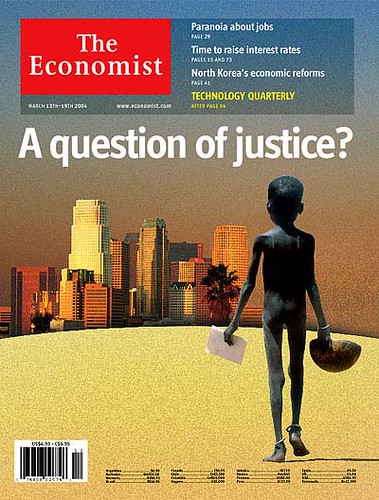
The March 13th 2004 edition of The Economist had a central article on poverty and inequality. On the cover of the magazine a skinny, naked African boy walks slowly over a brilliant desert, heading towards a first world city downtown (the image also hinted at the waves of immigrants that enter the first world each day in the search of a better life). The article triggered a response from Martin Ravallion (a World Bank researcher), published in The Economist on April 7th, mainly focused on the discussion of the different methodologies to get the data on poverty. On May 5th, Mr. Martin Wolf wrote an article on the Financial Times, showing how Globalisation (that “pantomime villain”), has in fact, being an important cause of poverty reduction during the last two decades.
All these articles carried an optimist vision. By different measures, Global poverty is decreasing; China and India are growing faster and steadily, and millions of their citizens are getting out from the “less than 1$ a day” pit hole (although that’s not the case for Africa); and Global Inequality has returned to the 1950’s level (a GINI index of 63). These are positive signs, but nevertheless, the figures on inequality are disappointing.
If the world were a country, it would be the most unequal nation on earth. Well, it is. According to the 2002 World Development Indicators (published by the World Bank), only five countries have GINI indexes above 60: Sierra Leone – 62.9; Central African Republic – 61.3; Swaziland – 60.9; Brazil – 60.7; and Nicaragua – 60.3. South Africa is 59.3 and Colombia 57.1. Some of these countries even have a similar per capita Income (at purchasing power parity) as the World ($7,820). In this sense, the fact the global GINI index has diminished from 67 in 1980 to 63 in 2000, may be the right trend but not something to make us happy, and definitely, not good enough (the standard in developed countries varies between 25 and 40). Growth may lead to where everyone wants to go, but a more equal world, given today’s global wealth, would help to get there faster.
Rich countries know better than anyone that a more equal society, with better educated and informed people, becomes the center of a virtuous circle that allows a nation to achieve prosperity. That configuration would work the same for the world as whole. Poor countries already have to work hard to get on the growth track. The rules of globalisation have to be designed with a more equal world in mind, with rich states and international institutions influencing in a progressive way the forces of the market economy. Don’t expect growth to do the entire job because it won’t.
That’s why it is vital to get the subject of poverty and inequality to the front pages and put the issue at the top of the global agenda. If the world is a dangerous, fearful place, as many in the so-called first world perceive it, it’s not because of international terrorism or unintelligent geopolitical decisions, but because an unequal world, like ours, is condemned to be such a place.
Sources: worldbank.com
CARLOS PERALTA-CACERES
2 comments:
Carlos, that was a great post. I completely agree with you. Instead of focusing on this "war on terror" by removing evil dictators and pursuing military interventions, it would be better to fight a "war on poverty" (sorry about the war metaphor, it seems to be popular with those in power!)...after all, that's where a lot of problems begin.
Wikipedia explains a bit about the Gini coefficient.
A question that should be answered as well: is it sustainable if all countries have growth rates like India and China? Is even the current global growth rate sustainable for the next decade?
ciao,
(...from probably the poorest war-free country)
Post a Comment